World Demolition Awards shortlists part 1
28 October 2020
- Category: Contract of the Year $1m or Over
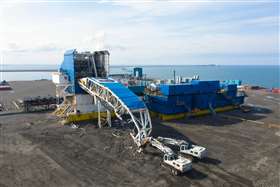
Brandenburg Industrial Service Company
Country USA
Project Liberty Rig
Client BP Exploration Alaska
SDI Island in Prudhoe Bay, Alaska is located about 965 km (600 miles) north of Anchorage and about 1,900 km (1,200 miles) south of the North Pole. The crew adjusted to 20 hours of daylight and lived in camp-like conditions. The weather conditions provided only one time of year to perform the work, so the project was scheduled for two summers.
Mobilisation of equipment required months of planning on top of a five-week delivery schedule. There was one road that provided access to the site and it was destroyed by flooding on the initial attempt to mobilise. Phase One was completed in the summer of 2018 and consisted of removal of universal wastes, over 20,450 litres (4,500 gallons) of fluids and the salvage of equipment for reuse. Phase Two occurred in the summer of 2019 and consisted of the removal of all structures and materials.
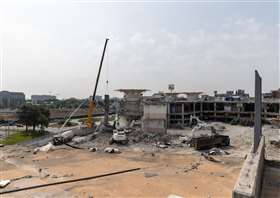
Despe
Country Italy
Project Auchan Shopping Centre
Client Cantieri Commerciali
This shopping centre on the outskirts of Milan was built in 2017.
The customer requested the demolition because there will be an even bigger one built, and Despe had never demolished such a new building. It was a great challenge and learning experience to demolish buildings different from those built in the 1950s and 1970s.
The shopping centre was made of reinforced concrete and steelwork with a floor surface area of 225,000 sq m (2.42 million sq ft), which had to be totally stripped out and demolished (above ground) in a short time. Approximately 20 operators and 15 operational vehicles were used during the strip out stage, which was done in six months.
During the demolition stage, which required the demolition of reinforced concrete structures with considerable thickness and reinforcement, about 20 excavators were used, four of which weighed more than 100 t.
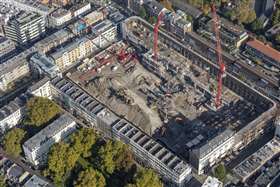
Erith Contractors
Country United Kingdom
Project Whiteleys Redevelopment
Client Finchatton
Representing one of Erith’s most prestigious projects to date is the Whiteleys Shopping Centre Redevelopment. With a footprint of 14,580 sq m (157,000 sq ft), the structure built more than 100 years ago is to undergo a £1 billion (US$1.32 billion) regeneration.
Erith commenced on a full enabling package including soft strip of the vast building, extensive temporary works to facilitate façade retention, and top down demolition of the internal structure.
Works then progressed to the basement excavation and piling works prior to being handed over to the appointed main contractor for the next phase of the redevelopment.
The project also involved huge heritage removal and storage of several features. These will be reinstated as key features of the new development. Additionally, all stonework removed to enable the demolition works were individually numbered and stored off site.
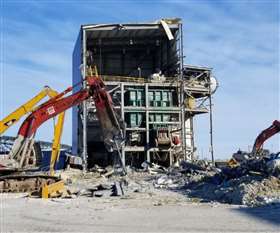
Priestly Demolition
Country Canada
Project Victor Mine Demolition Phase One
Client DeBeers Group of Canada
The Victor Mine Demolition project is a remote fly-in/fly-out project located in the James Bay Lowlands of Northern Ontario, approximately 90 km (56 miles) west of the coastal community of Attawapiskat First Nation.
This project has imposed major challenges from its planning to its execution, including a remote location and harsh weather requires extensive planning and contingency plans; working with indigenous communities offering employment opportunities; strict manpower clearance requirements; the employees going to the site needing to be medically and security cleared; access is only by plane or ice road in the winter requiring a Hercules plane programme to mobilise all equipment. The project also required a team of mechanics to re-purpose equipment normally used in mining for demolition applications.
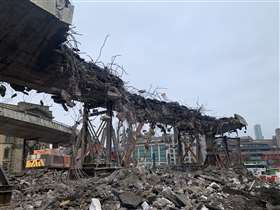
S Evans & Sons
Country United Kingdom
Project Churchill Way Flyover, Liverpool
Client Liverpool City Council
S Evans & Sons was tasked with removing Liverpool’s concrete overhead flyover bridges that spanned the length and breadth of the city centre and passed close to the famous art gallery, library and museum.
The structures also directly fed into the tunnel systems connecting the city centre to nearby areas and provided a vital route for almost 30,000 Liverpool John Moores University students.
To the untrained eye, this could seem a simple task. However, no hydraulic hammers and no vibration could be used with the site being so close to the museum and the demolition could not create any dust or noise during the removal of the 600 t sections and detachment from the overall bridge.
The complex answer was a combination of using engineered hydraulic jacking systems and surgically cutting the bridge into sections using diamond wire saws, all achieved over a stringent 28-week programme and without affecting the daily lives of local people, visitors and businesses in Liverpool city centre.
The latter included rerouting traffic to create zero noise.
Once demolished, these huge bridge sections were then transported on specially made transportation units, requiring a police escort, and then reprocessed for future regeneration projects.
This logistical challenge for the whole project was made successful thanks to over two years of planning and tapping into the knowledge of specialist engineering support.
- Category: Explosive Demolition
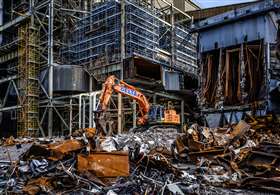
Alford Technologies/Delta Group
Country United Kingdom/Australia
Project Hazelwood Power Station Chimneys
Client Engie
The explosive demolition of eight concrete chimneys at Hazelwood Power Station, Australia, during the Covid-19 outbreak brought unique problems that required a huge amount of additional work to ensure a successful outcome.
Australia’s Delta Group selected Alford Technologies, a United Kingdom-based explosives company, to carry out the explosives work within the project.
The two companies worked closely for 12 months to develop the plans when Covid-19 struck.
With Alford suddenly physically cut off from the entire continent the decision on whether to postpone the job until after the outbreak or to proceed using a Plan B needed to be made rapidly.
A new team of experienced explosive engineers was recruited.
They needed to be brought up to speed on the detailed planning that had gone on for months and which continued right up to the moment the button was pressed.
Explosives are historically only used as a last resort in Australia so Delta had to manage a range of stakeholders, enlisting many third parties to consider all aspects of the demolition, in particular controlling the asbestos risk and perception of that risk.
Using Teams and WhatsApp, Alford and Delta worked closely to ensure that all work was verified and carried out properly, while the explosives command-and-control for the event was carried out remotely from the United Kingdom.
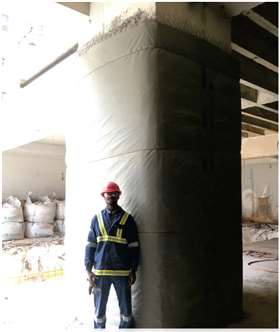
Jet Demolition
Country South Africa
Project Controlled Demolition of the Bank of Lisbon Building
Client Gauteng Department of Infrastructure Development
The Bank of Lisbon Building had been a landmark in central Johannesburg since the 1960s. In September 2018, three firefighters tragically lost their lives battling a raging fire within the building. The fire caused extensive structural damage and the building was condemned. The Gauteng Provincial Government awarded a turnkey contract to Jet Demolition to safely implode the building and clear the site for redevelopment.
The task was to implode the 108 m (354 ft) tall structurally compromised building within an extremely restricted basement footprint, without damaging nearby structures - the closest being only 7.8 m (25 ft) away. Perimeter walls of the five-storey basement were to be safeguarded for reuse, with no damage nor lateral movement permitted during the project. All unburnt office furniture and contents were to be recovered, catalogued, and stored. Asbestos abatement, soft-stripping and removal of burnt debris throughout the building was required to enable safe disposal of hazardous and other wastes, while segregating materials to achieve maximum levels of recycling.
Premature collapse of the compromised building was a serious concern. Extensive back propping, paired with an electronic movement detection system, was installed to safeguard against the primary failure risk of a cascading progressive collapse, and to monitor structural behaviour during implosion preparations. An emergency management protocol was implemented to facilitate rapid evacuation of the site and surrounding buildings, if necessary.
Electronic initiation of 920 kg (2,028 lb) of explosive within 2,363 individual charges enabled precise control of the progressive collapse with all rubble contained within the basement footprint and no structural damage to surrounding properties.
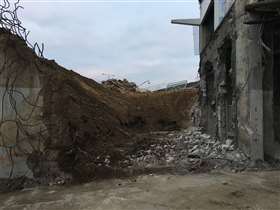
Precision Demolition
Country United Kingdom
Project Demolition of Barnsley Multi-storey Car Park
Client Henry Boot Construction
The car park in Barnsley, in the north of England, was close to a recently refurbished building. In the first instance, the 40 m (131 ft) high chimney at the east end was to have been removed by another contractor before the explosive demolition, but this was not permitted by Network Rail so the chimney had to be included as a last minute addition to the blast plan.
The new blast plan was going to require far more accurate timing of the firing of the charges and electronic detonators were needed to control the collapse far more precisely so that the car park would be sufficiently collapsed for there to be a void space into which the chimney could fall.
The collapse mechanism was that the north east corner would collapse first and then as the building progressively collapsed on time delays propagating to the west the air would be expelled to the retaining wall 7 m (23 ft) away and roads beyond that could be readily cleaned and not to the north east where we had a glass fronted railway signal box.
At the west it had been planned to mechanically demolish one bay of the car park, to provide a space between the car park and the market. As the end wall of the car park was removed it became clear that the gable wall of the market was constructed from a single thickness lightweight blockwork and not tied to the market frame.
- Category: Industrial Demolition
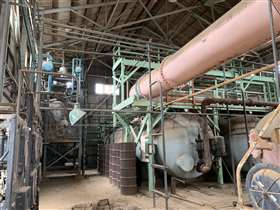
Demex
Country Australia
Project Demolition of Mulwala NC and First Stage Precinct Buildings
Client Australian Munitions (Thales)
The location and historical applications of the project site raised significant challenges which demanded expert approaches in hazard remediation to deliver the project in accordance with the strictest safety and environmental standards.
The project included the demolition of 43 buildings in the Mulwala explosives facility in regional New South Wales, on a site where propellant, high explosives and concentrated acids are manufactured.
Hazards to be remediated were complicated by a number of factors, including the scale of the operation; the number of workers on site operating concurrently in multiple work zones; potential for volatility as equipment engaged with high risk chemicals, often concealed; and removal of fragile, aged asbestos. All this had to take place while business as usual continued and Covid-19 protocols applied.
A strong focus on recycling and safe disposal meant 100% of concrete and steel was committed to recycling, with only 30 t of general solid waste going to local landfill. Asbestos waste was disposed of at a licensed landfill using Environmental Protection Authority licensed trucks.
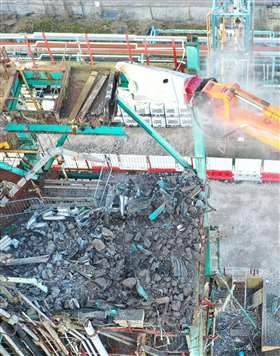
Erith Contractors
Country United Kingdom
Project Runcorn Chloromethanes Project
Client Inovyn
The Chloromethanes Project comprised asbestos removal, decontamination, deplant and demolition of a strategically important site in the north west of England. The site operation focus was the production of chlorine, caustic products and chlorinated derivatives, as well as one of the largest membrane electrolysis units in Europe.
Erith embarked on the asbestos removal, demolition, dismantling and site clearance of two significant Chloromethanes facilities, HCL plant and associated areas, including building and equipment collapse of various process plant structures, switch rooms, pipework, cables, pipe bridges, plant and equipment.
The technical nature of the construction gave rise to significant engineering challenges, which Erith managed safely, strategically and on programme.
The assets were a major COMAH (Control of Major Accident Hazards) hazard when in operation, located on an old site that was close to the River Weaver, nature reserves, live gas mains and site utilities.
They ranged in age from 35 to 70 years and were integrated into common effluent treatment and high voltage site infrastructure.
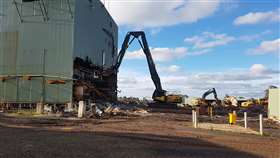
Liberty Industrial
Country Australia
Project Iluka Resources Programme of Demolition Works
Client Iluka Resources
Liberty Industrial was engaged by Iluka Resources to deliver a two-year programme of works comprising six demolition work packages to remove the former Iluka Resources mineral sands mining and processing facilities across several remote locations throughout Victoria and Western Australia.
When combined and executed consecutively these six work packages form an extensive industrial decontamination and demolition undertaking.
Naturally Occurring Radioactive Material (NORM) presented the project delivery team with a significant challenge, with large volumes of testing, segregation and decontamination required. A dedicated radiation safety officer was required to survey all material prior to them leaving site. For recyclable materials with readings above the statutory limits, a dedicated NORM wash bay was established to remove the radioactive material.
As well as using several heavy duty EC380 and EC250 Volvo excavators, Liberty also deployed high-reach excavators including a 48 t Volvo EC480DL and Kocurek modified EX1200 to demolish up to 24 m (78 ft).
Close to 50,000 man hours of work safely completed on the project without injury or incident and 95%, or more than 20,000 t of material was recycled across the works.
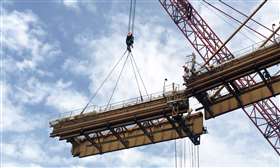
McMahon Services
Country Australia
Project Deconstruction and scrapping of quay and gantry cranes at PSA Singapore City Terminals
Client GoIndustry DoveBid (S)
McMahon Services believes the project demonstrated innovative, high-risk demolition and deconstruction engineering, with an exceptional recycling rate. The project was McMahon Services’ first in Asia, and through applying collaborative contracting principles, it was able to work with the client to achieve outstanding outcomes.
The project achieved a delivery production rate with 21,000 t of scrap dismantled and processed in an 11-month period.
In total the team dismantled 11 different models of crane from six different manufacturers, on average removing over 100 t per day during lifting operations.
The largest of the cranes weighed 872 t with a vertical height of 101m (331 ft), each one required detailed inspection and planning before deconstruction. The project hosted multiple work fronts, with over 200 major crane lifts during the dismantling works.
Using custom designed plant and equipment reduced the need to access potentially unsafe working environments and allowed the project to be complete.
Total work days for the project at completion was 296 days.
- Category: Manufacturers’ Innovation, Plant and Equipment
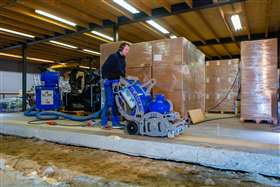
Blastrac
Country Netherlands
Product BMC-335Elite RC
The Blastrac BMC-335Elite RC is equipped with a 15 kW sawing motor and an electrical drive system. It is ergonomically designed so that it is easy to adjust the speed and tracking to enable it to turn 360°. The digital ammeter on the handle turns red when the maximum Amp is reached, which means that the working depth must be adjusted.
All the operations of the machine are controlled by the operator from an ergonomic remote control. Benefits of the remotely operated version include improved worker environment (as operators do not contact dust or vibrations from using the machine), as well as increased productivity. Blastrac estimates a minimum of 30% increase in productivity compared to a non-remote-controlled version. The operator can walk around the machine to check the surface, dust collector and hoses. Operations are also more precise.
The drum housing, which is surrounded by dust seals, is mounted in the frame by torque bushes which lower the vibration level. Thanks to this system, the product has a vibration level lower than 2.5 m/s2. Depending on the configuration of the sawing drum, it can adapt to any situation and any need. Due to the specially designed dust extract system inside the drum housing and its 100 mm local dust exhaust, the BMC-335Elite RC shaver is dust free when connected to the appropriate Blastrac dust collector.
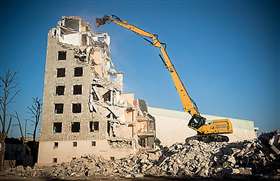
Caterpillar
Country USA/Switzerland
Product Cat 352 UHD
To develop the Next Generation of Cat demolition machines, the company focused on owners and operators.
This year, Caterpillar is not only launching a new model of a high reach demolition machine, completing the line-up with a 60 or 70 t excavator size class, but also a new generation of machine with the 352 UHD. This model will bring customers additional safety standards, improved performance and less fuel consumption; resulting in less emissions as well as less maintenance costs, by extending service intervals, while also prioritising safety and ease of operation for the operator.
Part of the development process was sustainability, with the goal of having a machine with a higher recyclability rate, to ensure more efficient usage of valuable natural resources, enhancing the end-of-life value of the product.
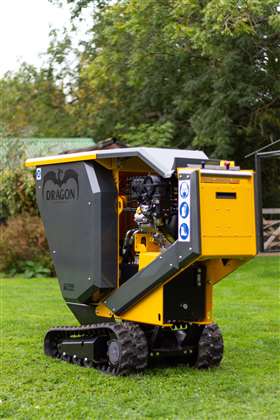
Dragon Equipment
Country United Kingdom
Product CR300H Hybrid Concrete Crusher
With the launch of its CR300H Concrete Crusher, Dragon Equipment says it has brought a revolution to on-site recycling. Not only is the crusher highly mobile, allowing access into confined spaces, but the addition of hybrid technology is said to enable safe operation with zero emissions. An additional advantage of its hybrid design is its ability to recharge the batteries quickly using the highly efficient Vanguard 400 single-cylinder petrol engine.
Its jaws can crush up to 7 t an hour of waste material into reusable hardcore. The adjustable jaws have three settings, which allows the operator to vary the size of the finished product that best suits either waste removal, reuse or onward sale. This ability to turn something that would usually have been put into a skip into usable material is at the heart of the Dragon Equipment ethos.
At 700 mm (27 in) wide and weighing under 780 kg (1,543 lb) Dragon believes that access to hard to reach spaces is no problem for the CR300H, and that with its single lifting point, tracking capability (remote control available) and optional conveyor it provides maximum versatility and is a key addition to any construction or demolition project.
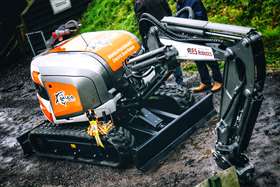
ES Manufacturing
Country United Kingdom
Product Akula Diesel and Electric Hybrid Robot
Each Akula robot has the option for either single or double dozer blades to be installed, with double supplied as standard. ES says that one of the biggest steps forward is with the ES Robotics Robo Power DC Motor, which with fully adjustable speed, torque and load sensing this DC Motor gives peak performance 100% of the time. The motor will run off reduced voltage supplies without any detrimental effects to the machine. Therefore these intelligent DC motors coupled with Robo Power require dramatically smaller generators to power the units. When used in diesel mode the Akula DR-Range uses the latest Kubota water cooled engine, giving an impressive amount of power. Engineered with the power to maximise performance, it also delivers minimised noise and vibration, meeting all current engine emission regulations.
- Category: Safety and Training
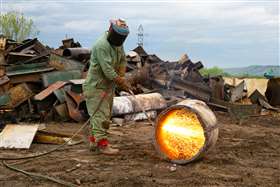
Brandenburg Industrial Service Co
Country USA
“All safety-related incidents are preventable; all hazards are correctable,” says Tom Little, president of NDA (National Demolition Association) member company Brandenburg.
“Health and safety is the foundational principle guiding behaviours and beliefs in this company for over 50 years.”
Brandenburg was the USA’s first demolition contractor to successfully complete the Challenge pilot programme, executed by the Occupational Safety and Health Administration (OSHA).
Brandenburg has subsequently participated in OSHA’s prestigious Voluntary Protection Programme.
Another corporate innovation involves a partnership between Brandenburg’s health and safety Division and equipment divisions. Together, they develop proprietary mechanical and vehicle solutions to enhance worker safety. For example, they designed a quick coupler for large equipment, such as excavators, which eliminates the need for manually placed pins to hold attachments. It prevents an attachment from coming loose and falling, potentially causing staff injury. They also developed an attachment cradle for the safe handling, installation, transportation, and storage of heavy attachments, such as hydraulic shears and concrete processors.
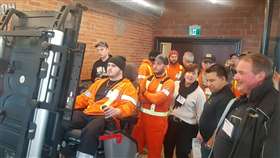
Budget Demolition
Country Canada
Highlights of Budget Demolition’s safety programme in 2019-20 include, in December 2019, achieving COR Certification, the culmination of a five-year overhaul of the entire safety programme. Up to June 22, Budget Demolition had worked 860 days with no lost time injuries, while the Budget Environmental Group and its five divisions achieved 461 consecutive days. Having engaged a translator to translate the health and safety programme into Spanish, the safety team continues to strategically roll out and implement the improved programme to each of Budget Environmental’s divisions.
Budget Demolition had another successful three-day full site shutdown 2020 Winter Safety Week programme, including unlimited access to Volvo’s Eexcavator simulator for the entire demolition team.
There has also been further restructuring of the safety department, with the director of safety becoming a full-time commitment.
Demoliciones Mitre
Country Argentina
Grupo Mitre is a demolition company with a history of more than 30 years that works daily to generate a collective awareness that “whoever is by our side is the most important”.
With the focus on training leaders, it seeks training inside the company using its own resources and looking outside for the ones that it does not possess.
It says safety and training has become part of its life, not only as a statistical matter, but in daily activities, with accidents and occupational diseases reduced.
Grupo Mitre is certified as B Corp, recognised as the first demolition company to achieve this certification worldwide.
To achieve this, it had to manage safety, environment, recycling and social skills.
Work permits, risk maps, evacuation plans, drills and five-minutes talks, reach every single person in Grupo Mitre, thanks to a multidisciplinary committee.
In addition of pushing forward the decision making to the front line, the presence of the company board in the field is a key part of the change, making everyone working feel they are part of a team.
Mitre says training is a key part of the company including conducting training inside the company using its own resources and looking outside where necessary, with the focus on training leaders.
Priestly Demolition
Country Canada
At the beginning of 2020, Priestly achieved COR certification in Ontario, demonstrating that the company’s health and safety management system is effective. Priestly’s focus on proactive safety reporting and senior management communications has strengthened its safety programme in 2020. In the past year, Priestly has started the process of bringing health and safety training programmes in house to allow for more flexibility and speed in delivering required training. An emphasis on two-way communication between management and staff has been heightened through quarterly town hall meetings, weekly safety communications and frequent senior management safety blitzes.
- Category: Urban Demolition under $10 million
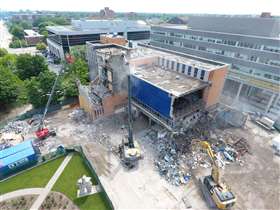
Budget Demolition
Country Canada
Project Old Windsor City Hall Extraction
Client City of Windsor
Budget Demolition mobilised to the site in January 2019. Starting with setting up the site, the team isolated the building from the surrounding improvements, parks, walkways using perimeter fencing.
The four-storey city hall was declared obsolete following the building of the new state of the art City Hall facility directly east of the old building. Having the new building so near presented a number of challenges to the project, including site access, limited workspace, dust migration, vehicle and pedestrian traffic flow and historical and sentimental monuments close by.
Another challenge was the asbestos in the building, the entire steel structure was coated in asbestos containing fireproofing. During the abatement, large amounts of additional unidentified asbestos was found. To expediate the project, workers onsite were increased, and the schedule was not impacted.
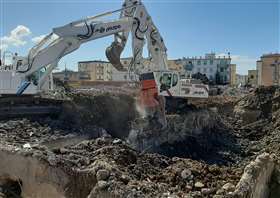
Despe
Country Italy
Project Esselunga Livorno
Client Esselunga
The project involved the demolition of an old industrial site formerly owned by the Fiat motor company, located in the centre of the coastal city of Livorno. It was abandoned a long time ago, resulting in serious abandonment conditions and inconvenience for the area,
Esselunga took over the area and decided to build the first supermarket in the area while trying to respect all the parameters of health and safety for the citizens and restoring an occupied and devastated area.
The activity was planned with zero impact on the environment and neighbouring areas – careful attention to the reclamation, no dust and no noise to prevent damage and disturbance to the population, while trying to restore and requalify the abandoned area.
Despe, which was awarded the tender thanks to its efficiency and guaranteed compliance with the parameters imposed by the customer, made sure its activities had zero impact, with reclamations in full compliance with current legislation minimising the impact on the population, with no dust and no noise.
Despe collaborated with local companies to reduce the impact on the environment and transportation with a considerable reduction of traffic in the city centre.
There were no accidents at the site.
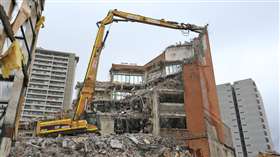
Flesan
Country Chile
Project Vivo Copesa demolition
Client Vivocorp
The project consisted of the dismantling and demolition of all former Copesa facilities in the district of Ñuñoa, Santiago de Chile. The site will house a new commercial project.
The dismantling consisted of the demolition of metallic storehouses which had perimetral partitions walls made of reinforced concrete and masonry. Those sheds were the former warehouses, printing room and newsrooms of the newspapers and magazines that the Copesa Group printed for national distribution. In addition, Flesan had to execute the complete demolition of the main building which housed several offices and the directory room. It was an eight-storey, 27 m (88 ft) high building with two basements underground.
Flesan executed the total demolition of 16.500 sq m, (177,600 sq ft) in eight months, without any major accidents or losses.
To accomplished this required a permanent staff of 20 people. Flesan Medio Ambiental staff from the company’s main office took care of all asbestos removal and moved all iron recycling to the authorised operators for final disposal.
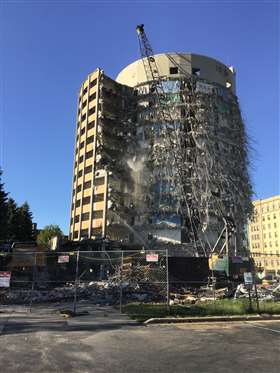
Veit & Company
Country USA
Project Marquette University Demolition
Client Marquette University
Veit & Company was hired as the subcontractor for the demolition and abatement of a 13-storey dormitory building at Marquette University in Milwaukee, Wisconsin, USA. This 54-year-old iconic building with its curved façade housed 725 beds and has been referred to as “the beer can” by generations of students.
Veit worked to an aggressive schedule and performed work simultaneously at different locations including multiple mobilisations, overtime, and multiple crews.
To meet the waste management plan goal of 75% waste diverted from landfill, Veit stripped out all non-recycled elements of the building prior before wrecking. The Veit crews worked from top down one level at a time to remove all non-recyclable materials including gypsum walls, furred out ceilings and exterior walls, flooring, roofing, and miscellaneous furniture.
Once these crews reached the basement level, all that was left was the core cast-in-place structure ready for mass demolition operations to begin.
To safely demolish the structure Veit hung a 15 x 30 m (50 x 100 ft) demolition screen, comprising a chain-link fence and silt screen, next to the public area of concern by means of a hydraulic crane. At the base of the screen was a 3.96 m (13 ft) tall steel bang board that deflected any materials caught by the screen back into the site rather than out into the public right of w
- Article originally published in the August-September 2020 issue of Demolition & Recycling International. To view the remaining shortlisted entries, please see next week’s D&Ri newsletter.
- To register free of charge for the World Demolition Summit (online, Thursday 12 November, 3pm UK time) and discover this year’s award winners in real time, please visit demolitionsummit.com
